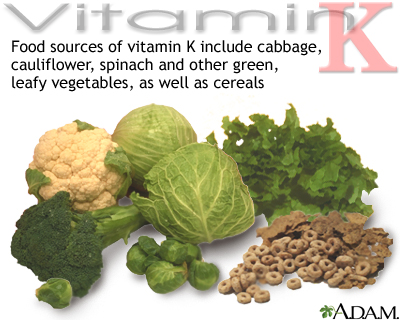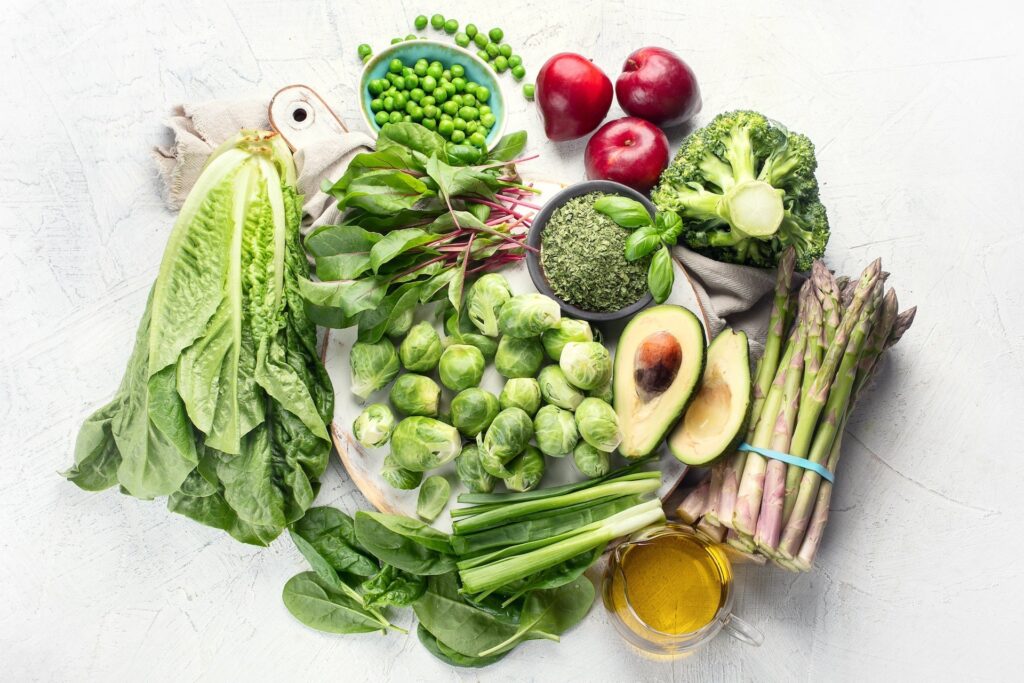Vitamin K helps your body by making proteins for healthy bones and tissues. It also makes proteins for blood clotting. If you don’t have enough vitamin K, you may bleed too much.
Vitamin K is known as the clotting vitamin, because without it blood would not clot. Some studies suggest that it helps maintain strong bones in the elderly.

Newborns have very little vitamin K. They usually get a shot of vitamin K soon after they are born.
If you take blood thinners, you need to be careful about how much vitamin K you get. You also need to be careful about taking vitamin E supplements. Vitamin E can interfere with how vitamin K works in your body. Ask your health care provider for recommendations about these vitamins.
There are different types of vitamin K. Most people get vitamin K from plants such as green vegetables, and dark berries. Bacteria in your intestines also produce small amounts of another type of vitamin K.
Signs of Deficiency
Vitamin K deficiency in adults is rare, but may occur in people taking medications that block vitamin K metabolism such as antibiotics, or in those with conditions that cause malabsorption of food and nutrients. A deficiency is also possible in newborn infants because vitamin K does not cross the placenta, and breast milk contains a low amount. The limited amount of blood clotting proteins at birth increases the risk of bleeding in infants if they are not given vitamin K supplements. The following are the most common signs of a deficiency.
- A longer time for blood to clot or a prolonged prothrombin time (as measured in a physician’s office)
- Bleeding
- Hemorrhaging
- Osteopenia or osteoporosis
Food Sources

The best way to get the daily requirement of vitamin K is by eating food sources. Vitamin K is found in the following foods:
- Green leafy vegetables, such as kale, spinach, turnip greens, collards, Swiss chard, mustard greens, parsley, romaine, and green leaf lettuce
- Vegetables such as Brussels sprouts, broccoli, cauliflower, and cabbage
- Fish, liver, meat, eggs, and cereals (contain smaller amounts)
Vitamin K is also made by the bacteria in the lower intestinal tract.
Vitamin K deficiency is very rare. It occurs when the body can’t properly absorb the vitamin from the intestinal tract. Vitamin K deficiency can also occur after long-term treatment with antibiotics.
People with vitamin K deficiency are often more likely to have bruising and bleeding.
If you take blood thinning drugs (such as anticoagulant/antiplatelet drugs), you may need to limit vitamin K foods. You may also need to eat a consistent amount of vitamin K containing foods on a day to day basis if you consume these foods. You should know that vitamin K or foods containing vitamin K can affect how these drugs work.
It is important for you to keep vitamin K levels in your blood about the same from day to day. Ask your health care provider how much vitamin K-containing foods you should eat.
The Recommended Dietary Allowance (RDA) for vitamins reflects how much of each vitamin most people should get each day.
- The RDA for vitamins may be used as goals for each person.
- How much of each vitamin you need depends on your age and gender.
- Other factors, such as pregnancy, breast-feeding, and illness may increase the amount you need.
The Food and Nutrition Board at the Institute of Medicine Recommended Intakes for Individuals – Adequate Intakes (AIs) for vitamin K:
Infants
- 0 to 6 months: 2.0 micrograms per day (mcg/day)
- 7 to 12 months: 2.5 mcg/day
Children
- 1 to 3 years: 30 mcg/day
- 4 to 8 years: 55 mcg/day
- 9 to 13 years: 60 mcg/day
Adolescents and Adults
- Males and females age 14 to 18: 75 mcg/day
- Males and females age 19 and older: 90 mcg/day for females (including those who are pregnant and lactating) and 120 mcg/day for males
Vitamin K

Vitamin K is a fat-soluble vitamin that comes in two forms. The main type is called phylloquinone, found in green leafy vegetables like collard greens, kale, and spinach. The other type, menaquinones, are found in some animal foods and fermented foods. Menaquinones can also be produced by bacteria in the human body. [1]
Vitamin K helps to make various proteins that are needed for blood clotting and the building of bones. Prothrombin is a vitamin K-dependent protein directly involved with blood clotting. Osteocalcin is another protein that requires vitamin K to produce healthy bone tissue.
Vitamin K is found throughout the body including the liver, brain, heart, pancreas, and bone. It is broken down very quickly and excreted in urine or stool. Because of this, it rarely reaches toxic levels in the body even with high intakes, as may sometimes occur with other fat-soluble vitamins.
Recommended Amounts
AI: An “adequate intake” (AI) is used when there is not enough evidence to establish a Recommended Dietary Allowance (RDA). The AI amount is estimated to ensure nutritional adequacy. For adults 19 years and older, the AI for vitamin K is 120 micrograms (mcg) daily for men and 90 mcg for women and for those who are pregnant or lactating.
Vitamin K and Blood Health , Bone health, and Heart disease
Blood clots: Vitamin K helps to make four of the 13 proteins needed for blood clotting, which stops wounds from continuously bleeding so they can heal. People who are prescribed anticoagulants (also called blood thinners) to prevent blood clots from forming in the heart, lung, or legs are often informed about vitamin K. Because of its blood clotting action, vitamin K has the potential to counteract the effects of blood thinning medications. A common method that estimates blood levels of vitamin K is measuring prothrombin time (PT), or how long it takes for blood to clot. People on anticoagulant medication such as warfarin (Coumadin) may be advised to eat a consistent amount of vitamin K from food and supplements. Although minor changes in vitamin K intake rarely affects PT, large and sudden variations in intake can alter PT levels and interfere with the medication’s effectiveness. Vitamin K is not a required listed nutrient on the Nutrition Facts label, but people taking anticoagulant medication are usually provided information about foods containing vitamin K from their health care provider.
Bone Health: Vitamin K is involved with the production of proteins in bone, including osteocalcin, which is needed to prevent the weakening of bones. Some studies have shown that higher vitamin K intakes are associated with a lower incidence of hip fractures and low bone density. In addition, low blood levels of vitamin K have been linked with low bone density. A report from the Nurses’ Health Study suggests that women who get at least 110 mcg of vitamin K a day are 30% less likely to break a hip than women who get less than that. Among the nurses, eating a serving of lettuce or other green, leafy vegetable a day cut the risk of hip fracture in half when compared with eating one serving a week. Data from the Framingham Heart Study also showed an association between high vitamin K intake and reduced risk of hip fracture in men and women and increased bone mineral density in women. However, the results of clinical trials and meta-analyses have been conflicting whether vitamin K supplements reduce bone fractures. This may be due to a variety of other factors that affect bone health, including a lack of calcium, vitamin D, and weight-bearing exercise, all of which might mask a benefit of vitamin K supplementation.
Heart disease:A few studies have researched the role of vitamin K for heart health. Vitamin K is involved with the production of matrix Gla proteins (MGP), which help to prevent calcification or hardening of heart arteries, a contributor to heart disease. Because research in this area is very limited, additional studies are needed before a specific amount of vitamin K beyond the standard recommendation is proposed for this condition.
